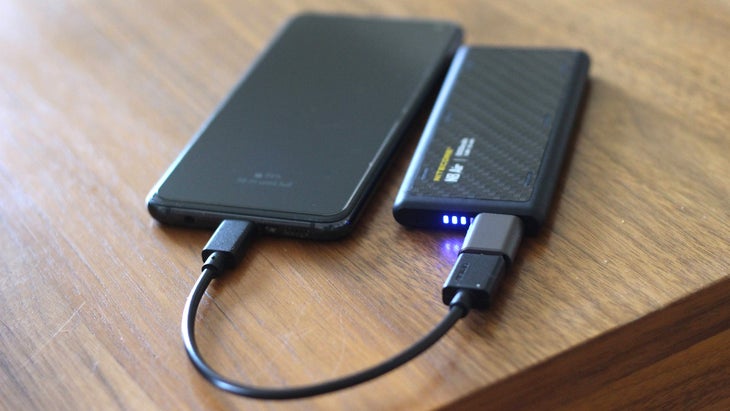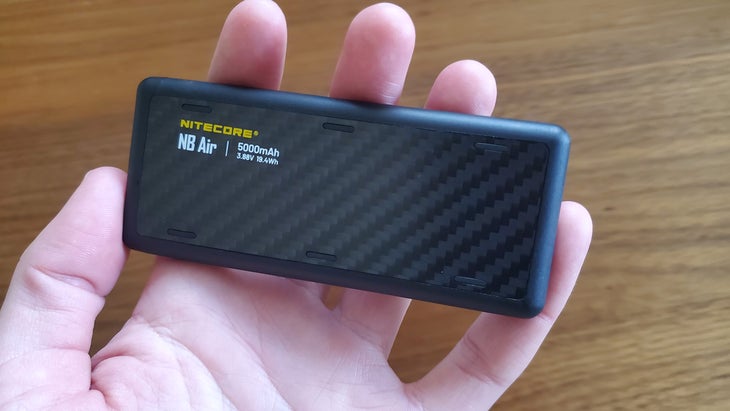Heading out the door? Read this article on the new Outside+ app available now on iOS devices for members! Download the app.
Whether you’re sweating over ounces in a headlamp or hauling your e-reader and DSLR into the backcountry, electronics can add a chunk of weight to your load. That’s one reason we’ve always been interested in Nitecore’s line of ultralight power banks. With so many electronics to keep topped up, a reliable power source that also saves some weight is a hot ticket for many hikers. So when the brand announced the release of the NB Air, its latest and lightest power bank, we knew we had to check it out for ourselves.
The Weigh-In
By any measure, the NB Air is diminutive. On our scales, it comes in at 3.2 ounces, 2 grams over the advertised weight. It’s about the thickness of a smartphone, and just under 2 inches wide and 4.5 inches long—small enough to fit in just about any pocket on a hiking pack. It’s rated to 5,000mAh, though we’ll take this opportunity to explain that all power banks are labeled according to their capacity, not the energy they actually deliver. After accounting for energy loss (through heat, connections, et cetera), the NB Air delivers about 3,300mAh of power—enough to fully charge most phones (but not the latest, power hungry models that have batteries of 4,000-5,000mAh). At $37, it’s about $10-15 more expensive than its competitors.
The NB Air achieves its impressive specs in two ways. First, the actual battery is slightly denser, and therefore more efficient, than previous models. Secondly, the casing is incredibly light: Nitecore claims that the plastic and carbon fiber housing weighs just half an ounce. Despite that, the NB Air feels quite solid in-hand. The case doesn’t bend or flex easily, and the rounded corners ensure it won’t snag against pockets or other delicate fabrics.
So, is it the lightest 5,000mAh power bank ever? No. There’s the 21700 class of cells like the Fenix ARB-L21-5000U, which weigh about 2.6 ounces but also have much lower charging speeds, deliver less power overall, and almost no additional features. And other competitors, like the 3.5-ounce Anker Nano 5,000mAh, come in just a bit heavier, but have added features and built-in cables. Still, our opinion is that the NB Air has the best mix of features in its weight class. Let’s get into the details.

Charging Speed
During our testing, the NB Air performed admirably on the technical front. The latest iPhones can charge at about 27-28 watts, max. The NB air offers 18 watts of output for charging—not quite lightning fast, but definitely speedy. My rather outdated Samsung device, which only supports 15-watt charging, got a full charge in about 90 minutes. Recharging the power bank takes roughly the same amount of time. In all, while the NB Air can’t compete with heavier, higher-powered rivals, it’s no slouch. For charging phones, headlamps, and satellite messengers, it’s perfectly serviceable. Bonus feature: The NB Air does charge from solar panels, a trait that some USB-C power banks, including the Anker Nano, lack.
Waterproofing
Aside from its diminutive weight, the NB Air’s best perk is its waterproofing. It comes with an IPX7 rating, which means it should be able to handle being submerged in one meter of water for up to 30 minutes. We were skeptical, since there’s no USB port cover, but ended up pleasantly surprised. We fully submerged the charger for 30 minutes, shook the water off, and plugged it in without waiting for the USB port to dry out. It seemed totally unaffected.
Since we’ve only been testing for a few weeks, we can’t judge how it will hold up to years of wet-weather use, but so far it seems excellent. This is a clear advantage of the NB Air. It has among the best waterproof ratings of the Nitecore power bank line (the popular NB10000, for example, has a lower IPX5 rating). Many competitors, including the Anker Nano, don’t advertise a waterproof rating.
The Not-So-Good
There are a few features missing from the NB Air—no surprise given its minimalist design. There’s only a single USB-C port, so there’s no way to charge two devices at once. The single input/output port also means there’s no pass-through charging. For thru-hikers who often have limited charging time in town, being unable to charge the power bank and a phone simultaneously through a single outlet is a big miss.
We noticed that the NB Air is finicky when it comes to connectors and adapters, which is likely a quirk of the single, bi-directional charge port. If you use adapters and older cords with mini-USB or USB-A ports, they’ll probably only work in one configuration, although we never ran into an adapter that didn’t work at all.
Lastly, there’s no screen display to show a battery percentage. Like most other Nitecore power banks, the NB Air has four LED lights to indicate battery life. It’s certainly better than nothing, but it only gives you a ballpark estimate of remaining battery life.

Does the NB Air Deserve a Spot in Your Pack?
The NB Air is a top pick for any trip where you only need to charge your phone once. It has close competitors like the Anker Nano 5,000mAh, but both have their pros and cons. The NB Air has a slimmer profile, better protection against the elements, and can charge off of solar panels. The Anker Nano has a built-in cable, supports pass-through charging, but is more susceptible to water damage and doesn’t support solar charging. For thru-hikes and other long-term adventures, the NB Air’s lack of pass-through charging is its biggest flaw, because you’ll either have to carry an extra wall charger (added weight) or swap out devices as they charge (added annoyance). Given its tiny size and weight, it’s a great choice to leave in a trail running pack or bike bag for emergency use.
